#canaanite pagan
Explore tagged Tumblr posts
Text
Two prayers from ancient Ugarit
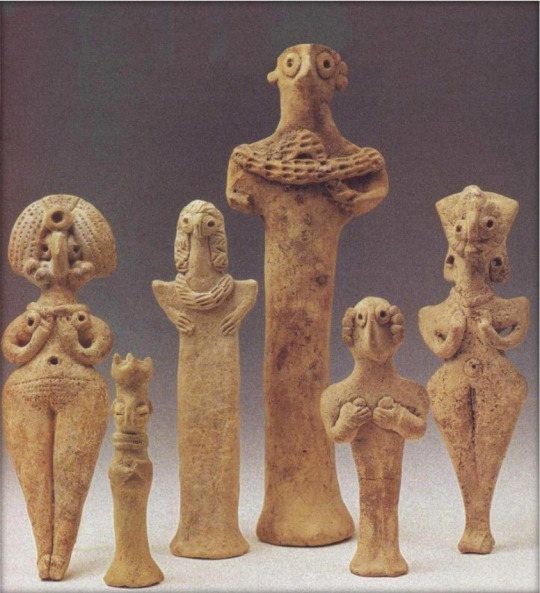
Various "Teraphim" figures representing deities for devotional purposes from ancient Canaan/Judah. Photo from "Exhibit from the Bible Lands Museum" (Biblical Archaeology Review Vol. 25:5 (Sep.–Oct. 2000), p. 22). Source: Fertility Goddesses from the Ancient Near East (Mar. 2000) by Wanda Roux, https://www.semanticscholar.org/paper/Fertility-goddesses-from-the-Ancient-Near-East-Roux/218a301d5b1f807dd2324e37257cc817912ceeed.
Shulmu 𒁲𒈬 to all! These are a couple more Ugaritic prayers I've given my own take on and filled in blanks based on scholarly texts. The first of these is addressed to 𒀭Prince Ba'al and is found appended to a bimonthly itinerary of Temple rituals classified as KTU 1.119 (=RS 24.266). My source for the text is Pardee 2002 (I mention these works often enough I figure I'll probably make a bibliography), pp. 50–53, 149–50 and the translation in Wyatt 2002, pp. 416–22. The next prayer, found on tablet KTU 1.65 (Wyatt 2002, pp. 363–65), also has a liturgical character and appears to have originally been concerned with the wellbeing of the a City of Ugarit. I've tried to adjust language in both prayers to make them flow as well as possible in English with a distinct ancient tone and I really hope you like what I've got here.
Prayer to Ba'al for Protection
When a terrible foe storms your gate,
a marauder dashes your walls,
You shall lift up your eyes to 𒀭Ba'al and say:
“O 𒀭Ba'al, if You drive the terrible foe from our gate,
“banish the marauder from our walls,
“an offering, O 𒀭Ba'al, we shall sanctify,
“a vow, O 𒀭Ba'al, we shall fulfill;
“a heritage, O 𒀭Ba'al, we shall sanctify,
“a Propitiation, O 𒀭Ba'al, we shall fulfill,
“a feast, O 𒀭Ba'al, we shall offer;
“to the Sanctuary, O 𒀭Ba'al, we shall ascend,
“the paths of the Temple, O 𒀭Ba'al, we shall follow.”
and 𒀭Ba'al will hear your prayer:
He will drive the terrible foe from your gate,
banish the marauder from your walls.
Prayer to El and the Family of the Gods
O Gods of the House of 𒀭El,
Family of the Gods,
Assembly of the Gods,
𒀭Thukamuna and 𒀭Shunama.
O 𒀭EI and 𒀭Ashirat,
Show us grace, O 𒀭El,
Come to our assistance, O 𒀭El,
Grant us peace, O 𒀭EI.
𒀭EI, come close,
𒀭EI, be our guard,
for the love of 𒀭Ba'al of Sapon,
for the hope in 𒀭Ba'al of Ugarit.
By the Holy Spear,
by the Holy Axe,
by the Holy Mace,
by the Holy Javelin.
By the Holy Burnt-Offering,
by the Holy Perpetual Offering,
by the Holy Morning Offering,
by the Holy Evening Offering.
By the Holy Censer and Lyre,
by the Holy Image and Propitiation,
by the Holy Threshold and Keystone,
by the Holy Song and Scribal Instruments,
by the Holy Grain-Offering and Young Wine.
O Gods of the Holy Mountain,
Gods and Goddesses in the Dwelling and Court,
remember us at the Assembly in Council,
by your rulings grant us peace in your good time.
#semitic pagan#semitic paganism#pagan#paganism#ancient history#ancient near east#history#canaanite paganism#canaanite pagan#canaan#canaanite#el#asherah#baal#gods#goddess#goddesses#spirituality#polytheism#polytheist#canaanite polytheism#ugarit#ancient levant#faith#religion#ancient religion#ancient world#phoenicia#bronze age#ugaritic
10 notes
·
View notes
Text
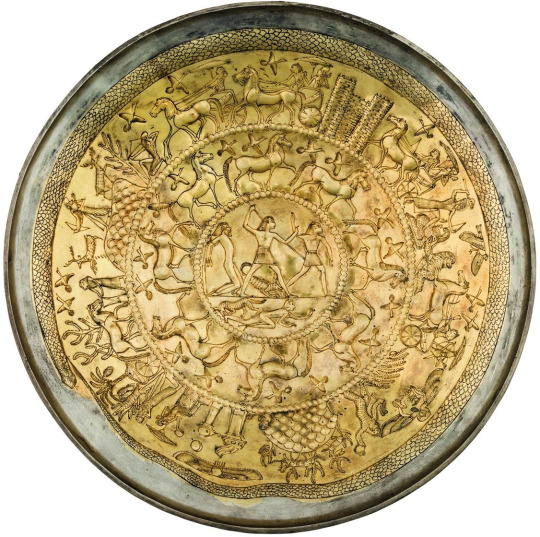
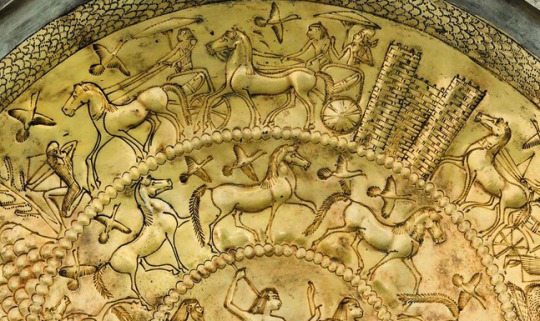
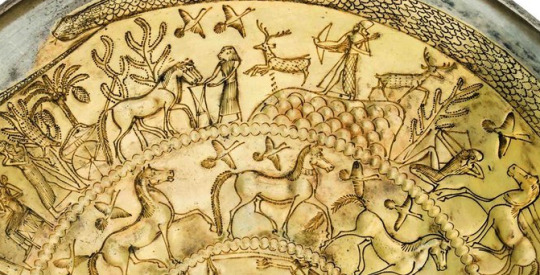
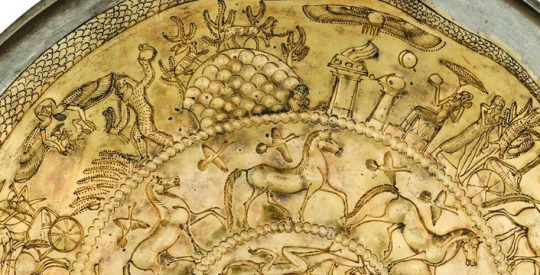
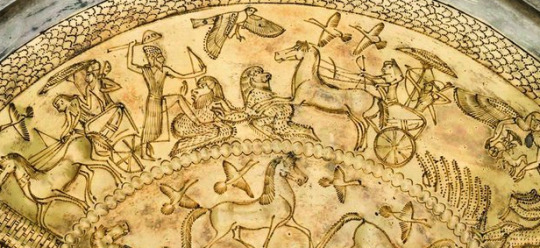
Phoenician Bowl with encircling Serpent Bernardini Tomb (Palestrina, Italy) c. 700 BCE The National Etruscan Museum of Villa Giulia Rome, Italy
#cyprus#rome#italy#egypt#egyptian gods#canaan#canaanite gods#phoenicia#phoenician gods#aram#aramean gods#syria#syrian gods#levantine gods#mesopotamia#mesopotamian gods#pagan gods#polytheism#archeology#magic#witchcraft#witchblr#paganblr#occult#uroboros#ouroboros#warfare#hunting#soldiers#birds
1K notes
·
View notes
Text
Steven Dillon's conversion to Christianity: what does it mean to Hellenism and Pagan Community?

Steven Dillon, the author of "The Case for Polytheism" and "Pagan Portals - Polytheism: A Platonic Approach", recently returned to Christianity.
This event made me think a lot. I think this event can teach us that the more you are concerned with "the One" and you think it can respond, the more likely you will go towards monotheism.
The point is that "the One" is us, and is "a thing", not "somebody".
The One is not a person. This is the reason why we worship the Gods, they are persons.
The One, the All, is so big that the idea that it can listen is nonsense.
Monotheism emerges when you think the entire universe can listen to you. Polytheism is the humbleness to understand that only certain parts of the Universe can listen to you.
And when you think you are talking to the One you are always actually talking to a part of it.
This is the reason why Christ, Yahweh, Allah, etc. are parts of the One and not the One.
Even attempts to interact with the entirety of the One are just interactions with parts of the One, ie one of the many Gods.
This is confirmed by Aleister Crowley's experience, we can read from the Liber Astarte Vel Berylli that he considered Allah, Christ and Yahweh as Parts or Aspects of the One, exactly as other Polytheistic Deities, and not as the All/the One in its entirety:
"Let the devotee consider well that […] Christ and Osiris be one […]".
"As for Deities with whose nature no Image is compatible, let them be worshipped in an empty shrine. Such are Brahma, and Allah. Also some postcaptivity conceptions of Jehovah".
"[…] the particular Deity be himself savage and relentless; as Jehovah or Kali."
-
Moreover, Dillon was (is?) Platonic, and the problem is even worse, because sadly the reaction to the problem of evil is very similar between Platonism and Christianity.
However, the Stoic (and maybe the Hindu and Buddhist) worldview completely destroys the problem of evil, because if the Divine is good and we simply don't perceive the goodness and that is what evil is, ie ignorance or misperception, then the problem of evil is solved.
If we, instead, perceive the evil as something real and the Gods as totally good not evil, the problem of evil remains.
-
Finally, a Pagan that comes back to Christianity usually doesn't know history very well, and is unaware of Natib Qadish, ie Modern Canaanite Religion or Neopaganism.
If you listen to Natib Qadish (ie Canaanite and Israelite Polytheistic Neopaganism) and Wathanism (Arabian pre-Islamic Polytheistic Neopaganism) practitioners' voices, you cannot come back to Christianity.
In fact, Christianity doesn't make any sense: Yahweh is a Storm God that comes from Edom to Israel through the Kenites or Shasu, which were nomads. His name meant "to blow", and so he was a variation of Baal Hadad.
In the origin, El was the father of Baal/Yahweh, and his sister was Anat and his mother Asherah. Later, El ie the Sky God and Yahweh ie the Storm God, merged and so Yahweh was seen as the husband of the Goddess Asherah.
In fact in Kuntillet Arjud it's possible to see blessings by "Yahweh and his Asherah". Moreover, even the Bible (read The Book of Judges) witness that people worshipped Asherah/Astarte and Baal together with YHWH.
In Elephantine in Egypt there was a Jewish temple for Yahu-Anat, ie both Anat and YHWH.
So how can Jesus be the son of the only God Yahweh if Yahweh was never a monotheistic God before the Josiah's reform that made Judaism monotheistic?
If Judaism is originally polytheistic then Christianity makes no sense.
By reading the "Cycle of Baal" we'll discover the origin of the Biblical Deity (or Deities?).
youtube
I end my dissertation with some interesting quotes from the Bible:
Jeremiah 7:
"17 Do you not see what they are doing in the towns of Judah and in the streets of Jerusalem? 18 The children gather wood, the fathers light the fire, and the women knead the dough and make cakes to offer to the Queen of Heaven."
Jeremiah 44:
"17 We will certainly do everything we said we would: We will burn incense to the Queen of Heaven and will pour out drink offerings to her just as we and our ancestors, our kings and our officials did in the towns of Judah and in the streets of Jerusalem. At that time we had plenty of food and were well off and suffered no harm. 18 But ever since we stopped burning incense to the Queen of Heaven and pouring out drink offerings to her, we have had nothing and have been perishing by sword and famine.”
"19 The women added, “When we burned incense to the Queen of Heaven and poured out drink offerings to her, did not our husbands know that we were making cakes impressed with her image and pouring out drink offerings to her?”"
"25 This is what the Lord Almighty, the God of Israel, says: You and your wives have done what you said you would do when you promised, ‘We will certainly carry out the vows we made to burn incense and pour out drink offerings to the Queen of Heaven.’"
#Hellenism#Paganism#Polytheism#devotional polytheism#Christianity#Canaanite#Platonism#Neoplatonism#Natib Qadish#Youtube
35 notes
·
View notes
Text
by Jack Elbaum
Political commentator Candace Owens said on her YouTube show on Tuesday that the Star of David originated from an evil pagan deity and has only become associated with Judaism within the past few hundred years, continuing the prominent provocateur and media personality’s recent focus on Jews and conspiracy theories associated with them.
“Do you know the history of the Star of David?” she asked on her show. “I thought that that was associated traditionally, somehow, with Judaism.”
The right-wing firebrand went on to argue that, in truth, the Star of David only became associated with Judaism when European Jews decided to adopt it as a symbol comparable to the cross a few hundred years ago. Then, when the Zionist movement adopted it in the late 1800s, that is when it became the symbol people think about today, she claimed.
However, many Jewish ancient artifacts have been found to have the Star of David on them. There were also other cultures, including pagan ones, that used the symbol. Additionally, the term “Magen David” — the “shield of David” — is referred to in the Talmud, although not specifically as the six-pointed star symbol.
Owens said that the true origin of what is today called the Star of David was actually the Star of Remphan, a pagan god worshiped by the Canaanites and who was regularly offered child sacrifices. As proof, Owens showed a picture from the internet that claimed to depict the Star of Remphan as a six-pointed star. However, there is no agreed-upon idea of what the Star of Remphan is actually supposed to be.
She went on to link these stars with demons and sorcery.
It appears Owens gathered much of the information to make her argument from Wikipedia. “If it’s on Wikipedia … that just must mean that it’s such an irreversible fact,” she said.
#candace owens#moron#complete utter moron#star of david#wikipedia#star of remphan#canaanites#evil pagan deity
32 notes
·
View notes
Note
How it's feel working with asherah and what make you interested working with her
Asherah or Ashirat is a Goddess of fertility, love and life and the wife of the chief God El Elyon in the Canaanite pantheon, quite similar to Ashtar without the warlike associations. In fact, in my own gnosis (and in most Canaan interpretations) I consider Ashirat to the mother of Ashtar and Anat, that is the holy nurturing mother as opposed to the sexy sex feminine rage archetype that encompasses other aspects of Ashtar and Anat as love Goddesses.
Attar and Anat, while love deities, are not mother goddesses. They likely took their fertility aspects from their mother without becoming mother goddesses themselves
Many people have syncretized these three goddesses, especially in regards to Astarte (People say that Ashirat is Astarte rather than her mother) but I prefer to keep them separate. Anat’s individuality as a deity of savagery, war and violence and Attar’s individuality as a deity of carnal sex and pleasure feel distinct from Ashirat’s persona as a nurturing mother goddess. I see her as my primary “Mother Nature” deity, although she is more than Mother Earth, she is the mother of Mother Earth, and the sun and moon. But that’s all up to interpretation. (and they’re all derived from Inanna in some way or another)
Because my gnosis syncretizes Attar, Astarte, Aphrodite, and Lucifer, and Lucifer is my patron, Ashirat is a very important Goddess to me as the mother of Venus. I actually started recognizing Ashirat far before I even knew about Ashtar.
As the Asherim pole and the lady of the primordial sea she can be considered quite similar to Aphrodite, as she was one of the influences that came to establish the persona of Aphrodite. While her daughters Attar and Anat went on to establish the more carnal and aesthetic aspects of beauty, sex, and love, as well as the destructive egotistical aspects, Ashirat embodied the beauty, sex, and love that created the cosmos and heavens.
(The children of Gods are usually the Gods of more specific things in that domain. From Aphrodite and Ares we got Eros (Cupid), from Eros and Psyche we got Voluptas who represents physical pleasure and bliss. So from Ashirat and El we get Ashtar and Anat, who represent more specific aspects of love and beauty like carnal lust and revenge- violence born from love.)
As the wife of El (or Yahweh, or Ba’al… scandalous! Isn’t it so annoying when your boyfriends fight?) she is the mother of all heavenly hosts and sons, and I consider her to be the mother of all the Archangels. There is nothing to confirm this but I believe her 70, 77, or 88 sons to have been those angels. Due to her associations with Ba’al I wouldn’t be surprised if she was also the mother of a few daemon as well.
When I first began my work as a practitioner I was mentored by Archangel Jophiel, who directly lead me into Ashirat and gave grace and full authority to her. I believe she has that same authority over all angels and demons of El Elyon.
She has dominion over all animals of nature and life giving forces (water).
As a daily act of devotion I offer her clean water and tend to plants or help out animals (feeding birds, leaving water out for strays) I also take baths whenever I do rituals with her.
She often demands honour is also given to her consort in the same way that Hera demands her devotees also worship Zeus, but you can also easily worship her without having a defined father deity, lord knows she’s shared the stage with one too many egotistical men but that’s neither here nor there lol. In my experiences she has encouraged me to make peace with the divine father, and in my searching I found Ra and Anu, and that seemed to be good enough for her. She has been very warm towards the devotees of her daughters and anyone who works with any of her sons.
The only pet peeve of her that I’ve discovered is honoring her while dehydrated. Drink your water babes she worked so hard on it.
#witchcraft#magick#paganism#pagan#occultism#witch community#witch aesthetic#witchblr#demonology#grimoire#asherah#astarte#ishtar#inanna#lucifer#luciferian#canaan#canaanites#mythology#wife of god#deity work#deity worship#attar
39 notes
·
View notes
Text
I'm here for goth girl Anat
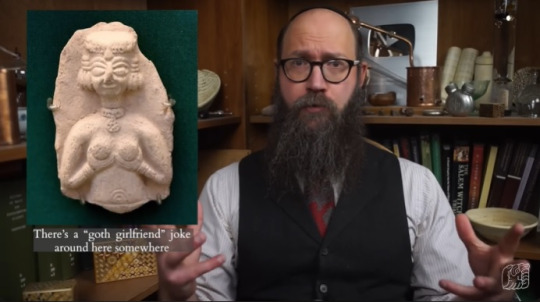
Are you?
#esoterica#anat#canaanite mythology#canaanite polytheism#ugaritic mythology#ugaritic polytheism#paganism#war gods#esoteric shitposting
13 notes
·
View notes
Text




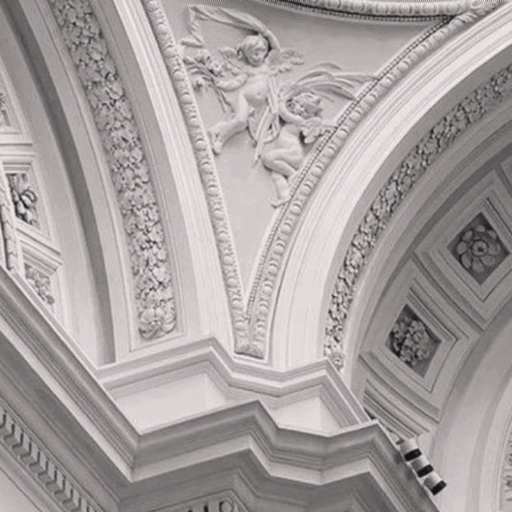



Asherah/Athirat/Elat = Mother goddess, queen of heaven, goddess of fertility, lady of wisdom, goddess of the seas, the creator of the gods together with the god El, queen of the gods, the one who walks on the sea, patron saint of sailors and fishermen
Athirat is a powerful Goddess, and the other Gods often ask Her to help them, or to try to influence her husband El for their good. As guardian of Wisdom, She is the one who chooses the successor of Aleyin (an aspect of Ba'al as the God of dying vegetation) and, after his death, She instructs Anat in the proper ritual necessary to ensure the fertility of the vines.
Like Ashtart, Athirat is associated with the lion. She is usually shown as a nude Goddess with curly hair covering her breasts with her hands. She is also associated with the snake, and an alternative name for Her is Chawat, which in Hebrew translates as "Hawah", or in English "Eve"; so She may well be the root of the biblical Eve. Like the Carthaginian goddess Tanit, whose name means "Serpent Lady", Athirat was represented as a palm tree or pillar with a snake coiled around her, and the name Athirat derives from a root meaning "straight".
Athirat is associated with the Tree of Life, and a famous ivory box lid of Mycenaean finish found at Ugarit, dated 1300 BC, shows it symbolically representing the Tree. She wears an elaborate skirt and jewelry, and although she is topless, her hair is delicately styled; She is smiling and in her hands holds sheaves of wheat, which she offers to a pair of goats.
#history#Asherah#asherah goddess#asherah#Goddess#canaanite religion#canaanite mythology#Phoenician mythology#mythology#biblical#biblical mythology#athirat#Mother#Biblical goddess#pagan#God's wife#El'wife#Wife of god#yahweh#God
88 notes
·
View notes
Text

Hadad from Canaanite religion.
The Canaanite religion encompassed the array of ancient Semitic beliefs followed by the Canaanite people in the ancient Levant, spanning from the early Bronze Age to the first centuries CE.
Hadad's representation featured a bearded figure adorned with a bull-horned headdress, wielding a club and a thunderbolt. As the consort of Atargatis and the father of Gibil or Girra, he held sway over land and human fertility. Linked to Zeus in Greek mythology, Jupiter in Roman lore, and Teshub in Hurrian beliefs, Hadad stood as a prominent and influential deity in the ancient Near East.
Follow @mecthology for more mythology and legends.
Pic generated using AI.
Source: Wikipedia and various.
#mecthology#mythology#myth#legends#hadad#Canaanite religion#canaanite#ancient#mitoloji#follow#zeus#gods#pagan
10 notes
·
View notes
Text
I would love to see more art of swana polytheist deities. If anyone knows swana artists who draw them, send them my way. 🫶
#ven talks#Canaanite paganism#arabian paganism#wathanism#arwahiyya#amazigh paganism#Kemetism#gunache paganism#semitic paganism#Ibadat al-Alihah#zoroastrianism
4 notes
·
View notes
Text
A suggestion from someone new to Canaanite Paganism
This sort of ties in to some local cultus kind of deal, but with Halloween coming up I was thinking about adding a Canaanite flavor.
Now this is sort of UPG but bear with me here. If you're a Canaanite pagan, you probably know about Mot.
He's the spooky God of death, always hungry for pretty much anything and everything (man or God alike), and he received absolutely ZERO offerings or worship. So around this time of year it could be that M/t is at his worst, looking for prey. Carve a scary face in a gourd or some other vegetable to scare him away.
Sort of like the ritual that pruned him like a grapevine.
#pagan#polytheism#witchblr#witchcraft#witch#paganblr#canaan#canaanite paganism#levpag#levantine#paganism
7 notes
·
View notes
Text
Deity Dagan
Originally a god of West Semitic speakers from the Levant, but worshipped widely throughout the Near East, including Mesopotamia.
Deity of grain, as well as its cultivation and storage. Indeed, the common word for "grain" in Ugaritic and Hebrew is dagan. According to one Sumerian tradition and to the much later Philo of Byblos, Dagan invented the plow. In the north, he was sometimes identified with Adad. Thus, he may have had some of the characteristics of a storm god. In one tradition his wife was Ishara, in another Salas, usually wife of Adad. Salas was originally a goddess of the Hurrians. Dagan also had netherworld connections. According to an Assyrian composition, he was a judge of the dead in the lower world, serving with Nergal and Misa-ru(m), the god of justice. A tradition going back at least to the fourth century BCE identified Dagan as a fish god, but it is almost certainly incorrect, presumably having been based upon a false etymology that interpreted the element "Dag" in Dagan as deriving from the Hebrew word dag "fish."
The earliest mentions of him come from texts that indicate that, in Early Dynastic times, Dagan was worshipped at Ebla. Dagan was taken into the Sumerian pantheon quite early as a minor god in the circle of Enlil at Nip-pur. Kings of the Old Akkadian peri-od, including Sargon and Narām-Sin, credited much of their success as conquerors to Dagan. Sargon recorded that he "prostrated (himself in prayer before Dagan in Tutul [sic]" (Oppen-heim, ANET: 268). At the same time, he gave to the god a large area of the country he had just conquered, including Mari, Ebla, and larmuti in western Syria. A number of letters from the Mari archives, dated mainly to the reign of Zimri-Lim, record that Dagãn was a source of divine revela-tion. The letters reported prophetic dreams, a number of which came from Dagan, conveyed by his prophets and ecstatics. In his law code, Hammu-rapi credits Dagan with helping him subdue settlements along the Euphrates.
The Assyrian king Samsi-Adad I commissioned a temple for him at Terqa, upstream from Mari, where funeral rites for the Mari Dynasty took place.
In the Old Babylonian period, kings of the Amorites erected temples for Dagan at Isin and Ur. In the Anzû(m) myth, Dagan was favorably coupled with Anu(m). At Ugarit Dagan was closely associated with, if not equated to, the supreme god El/I(u). Although he is mentioned in the mythic compositions of Ugarit as the father of the storm god Ba'lu/ Had(d)ad, Dagan plays only a very minor role. His popularity is indicated by his importance in offering and god lists, one of which places him third, after the two chief gods and before the active and powerful god Ba'lu/ Had(d)ad. Dagan is attested in Ugaritic theophoric names. In Ugaritic texts the god is often referred to as "Dagan of Tuttul." It might also be the case that one of the two major temples of the city of Ugarit was dedicated to him, and he might there have been identified with the chief god I(u) / El.
Festivals for Dagãn took place at Ter-ga and Tuttul, both of which were cult centers of the god. He was certainly worshipped at Ebla and also at Mari.
At Mari, in Old Babylonian times, he appears as fourth deity on a god list; that is, he was very important. He was venerated also at Emar. There a "Sacred Marriage" ritual between Dagan and the goddess Nin-kur was celebrated.
At the same city, a festival was held in honor of "Dagan-Lord-of-the-Cattle," at which the herds of cattle and prob. ably sheep were blessed.
According to the Hebrew Bible, Dagan was the national god of the Philistines. I Samuel:5-6 tells of the capture of the Ark of the Covenant by the Philistines. It was customary in the Ancient Near East for the conquerors to carry off the deity statues of the conquered to mark the surrender not only of the people, but also of their deities.
So the Philistines took the Ark, the symbol of the god of the Israelites, into the temple of Dagan at Ashdod. Since the Israelites had no statues of their deity, the much revered Ark was an obvious substitute. In this way, the Philistines marked the submission of the Israelite god to Dagan. However, on the next day, the people of Ashdod found the statue of Dagan lying face down in front of the Ark. The following day the same thing happened except that the head and hands of Dagan's statue lay broken on the temple threshold. This biblical account seems to be an etiology for a practice of the priests of the temple of Dagan at Ashdod, for it states that for this reason it is the custom of the priests of Dagan not to tread on the threshold as they enter the temple of Dagan. The best-known of the biblical stories that mention Dagan is in Judges 16, the tale of Samson and Delilah. After Delilah arranged for the Philistines of Gaza to capture Samson, they blinded him, shackled him, and made him a slave at a mill. During a festival to Dagan, the Philistines took Samson to be exhibited in Dagan's temple, where thou sands of Philistines had gathered for the celebrations. After praying to the Israelite god, the now long haired Samson got back his old strength. By pushing against two central pillars, he brought the temple crashing down on himself and on more Philistines than he had killed in his whole lifetime of killing Philistines.
— From a Handbook to Ancient Near Eastern Gods & Goddesses by Frayne & Stuckey page 67-69
#pagan#polytheism#levpag#philistines#israelites#canaanites#assyrians#1 samuel#tanakh#mesopotamians#dagan#dagan deity#deity#god#quote#sumerian polytheism#levant#ancient near east#landof2rivers#quote pile#put this in text for someone so thought id post it#eblaite#ebla
10 notes
·
View notes
Text
Proclaiming the Year of Aliyan-Ba'al
KTU 1.78 is quite a peculiar piece of ancient literature. It's an astrological report from Ugarit written in the City's own language and alphabet.¹ Despite being only six lines long, it has been the subject of extended discussion among scholars due to an ominous description of an astronomical event.² This event was identified early on by researchers with a solar eclipse dated to 1375 BCE, but a 1989 reexamination by astronomer Teije De Jong and Assyriologist W.H. van Soldt pointed to another solar eclipse, of 1223 BCE, as a more likely candidate.¹,³,⁴
This challenged the prevailing view of the timeframe of the Ugaritic texts.⁵ An even fuller picture thereof has emerged from research upon texts including those discovered in the house of a Diviner named Agaptharri.⁶ Three of these are particularly intriguing in relation to the Ba'al cycle, one of them even providing insight into the ritual aspect of the myth. It's classified as RS 24.293 and it involves 𒀭Mot, the God of Death who swallows up 𒀭Ba'al before being destroyed by 𒀭Maiden Anat to restore Her Brother to life.⁷
The Fourth Tablet of Ba'al itself, written by the scribe Ilimilku of Shuban under 𒀭'King Niqmaddu IV of Ugarit around the same time as the apparent eclipse, also contains a portion of broken text which bridges 𒀭Ba'al the Victorious' Great Theophany and His instructions to the Lads 𒀭Gapn and 𒀭Ugar to deliver His message to 𒀭Mot. Restoration of the text shows it appears to refer to the Sun, personified as 𒀭Shapshu the Luminary of the Gods, being cloaked in gloom as a grim omen.⁸,⁹ I think it's easy to see the connection I'm making here; I believe these two eclipses can be taken together as a sort of symbolic epoch.
The date was recorded as the Month of Khiyyaru during the New Moon which was the first Day of the Month in the Ugaritic calendar.¹ This lunar calendar has twelve months beginning just before the Autumnal Equinox in September. There was a modern version on Tess Dawson's Natib Qadish website but it's no longer present and I'm interested in repurposing it if I can figure out the math involved (especially with intercalation).
In any case, under the De Jong and van Soldt dating we are now in Year 3248 of Ba'al the Victorious starting in late Summer of 2024 and ending in late Summer of 2025. This is of course the first actual use of such a dating system, so it's only appropriate for it to take place on the civic New Year's Day. Shulmu 𒁲𒈬 and Happy New Year to all!
References
Wyatt, Nicolas. Religious Texts from Ugarit, 2nd ed, 366–67. The Biblical Seminar 53. London: Sheffield Academic Press, 2002.
Pardee, Dennis. Ritual and Cult at Ugarit, 131–32. Edited by Theodore J. Lewis. Writings from the Ancient World 10. Atlanta: Society of Biblical Literature, 2002.
De Jong, Teije, and Wilfred H. van Soldt. “Redating an Early Solar Eclipse Record (KTU 1.78): Implications for the Ugaritic Calendar and the Secular Accelerations of the Earth and Moon.” Jaarbericht Ex Oriente Lux 30 (January 1989): 65–77. https://www.researchgate.net/publication/274720180_Redating_an_Early_Solar_Eclipse_Record_KTU_178_Implications_for_the_Ugaritic_Calendar_and_the_Secular_Accelerations_of_the_Earth_and_Moon.
De Jong, Teije, and Wilfred H. van Soldt. “The Earliest Known Solar Eclipse Record Redated.” Nature 338 (March 16, 1989): 238–40. https://www.researchgate.net/publication/232779160_The_earliest_known_solar_eclipse_record_redated.
Pardee, 242.
Olmo Lete, Gregorio del, ed. “(Bn) Ảgpṯr / (Binu) Agapṯarri’s House: The Functional Analysis of an Ugaritian ‘Archive’ (PH Room 10).” In The Private Archives of Ugarit: A Functional Analysis, 27–54. Barcino Monographica Orientalia 11. Barcelona: Edicions de la Universitat de Barcelona, 2018. https://diposit.ub.edu/dspace/bitstream/2445/129766/1/9788491682394%20(Creative%20Commons).pdf.
Pardee, 211–14 (for the other two texts noted: Wyatt, 388–90 & 414–15).
Gibson, John C.L. Canaanite Myths and Legends, 66. Edited by G.R. Driver. London: T&T Clark International, 2004.
Wyatt, 111–12.
#pagan#semitic pagan#baal#anat#ugarit#canaan#paganism#semitic paganism#calendar#new year#astronomy#ancient near east#ancient history#shapash#history#shulmu#happy new year#ancient levant#bronze age#ugaritic#ugaritic mythology#canaanite#canaanite pagan#canaanite paganism#canaanite polytheism#polytheist#polytheism#phoenicia#phoenician#punic
9 notes
·
View notes
Text


El, Father of the Gods, and the King of Ugarit
Ugarit, Syria
13th century BCE
Top: Image from cover of "Stories from Ancient Canaan" by Michael David Coogan, 1978
Bottom: Ancient Near Eastern Pictures Relating to the Old Testament
James Pritchard, 1969
#el#ilu#elyon#el elyon#egypt#egyptian gods#canaan#canaanite gods#phoenicia#phoenician gods#aram#aramean gods#syria#syrian gods#levantine gods#mesopotamia#mesopotamian gods#pagan gods#polytheism#archeology#magic#witchcraft#witchblr#paganblr#occult#ugarit#ugaritic#ugaritic gods#ras shamra#king
256 notes
·
View notes
Text
Primordial Life Force
Goddesses Ashtoreth and Tiamat embody the primordial life force of the dragon.
Happy year of the Dragon.
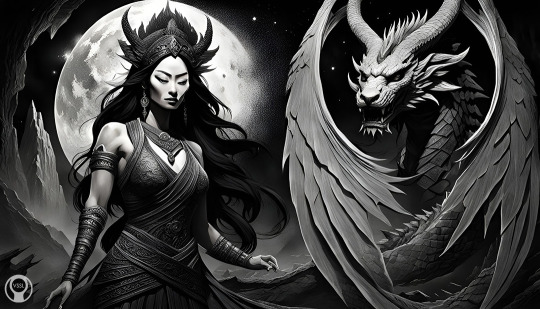
#year of the dragon#Ashtoreth#Tiamat#lny#lunar new year#cny#Akkadian#Sumerian#Canaanite#Mesopotamia#ancient dragons#Goddesses#channeled art#iconography#paganism#dragons#primordial#magick#esoteric#witchcraft
6 notes
·
View notes
Text
Drastic Measures Required
1 While Ezra prayed and made confession, weeping and casting himself down before the house of God, a very great assembly of men, women, and children, gathered to him out of Israel, for the people wept bitterly. 2 And Shecaniah the son of Jehiel, of the sons of Elam, addressed Ezra: “We have broken faith with our God and have married foreign women from the peoples of the land, but even now there…
#apostasy#Canaanites#cleansing#compromise#conviction#Ezra#Ezra 10#faithfulness#God#godliness#holiness#idolatry#intermarriage#Judah#obedience#pagans#purging#purity#separation#set apart#sin#the people of God
0 notes
Text
I LOVE THE WAY YOU DRAW HER SO MUCH OMG


'ANAT, goddess, betulat, hunter, warrior -- Queen of Heaven and lady of Palestine.
[CLICK IMAGES FOR BETTER QUALITY!]
136 notes
·
View notes